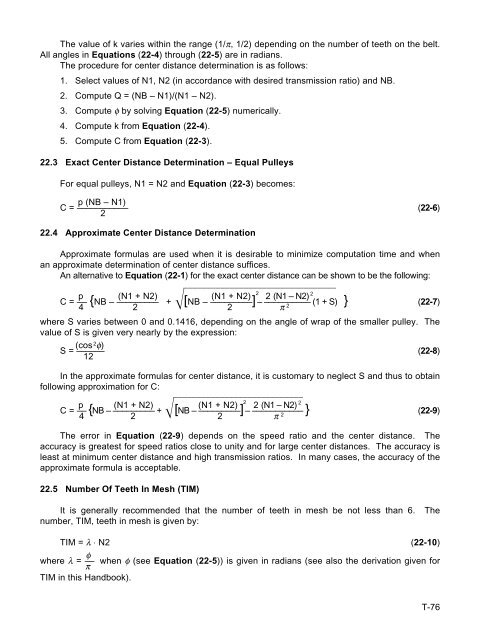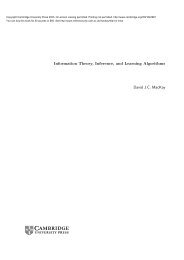THE WORLD OF TIMING BELTS - MAELabs UCSD
THE WORLD OF TIMING BELTS - MAELabs UCSD
THE WORLD OF TIMING BELTS - MAELabs UCSD
Create successful ePaper yourself
Turn your PDF publications into a flip-book with our unique Google optimized e-Paper software.
The value of k varies within the range (1/π, 1/2) depending on the number of teeth on the belt.<br />
All angles in Equations (22-4) through (22-5) are in radians.<br />
The procedure for center distance determination is as follows:<br />
1. Select values of N1, N2 (in accordance with desired transmission ratio) and NB.<br />
2. Compute Q = (NB – N1)/(N1 – N2).<br />
3. Compute φ by solving Equation (22-5) numerically.<br />
4. Compute k from Equation (22-4).<br />
5. Compute C from Equation (22-3).<br />
22.3 Exact Center Distance Determination – Equal Pulleys<br />
For equal pulleys, N1 = N2 and Equation (22-3) becomes:<br />
p (NB – N1)<br />
C = ––––––––––– (22-6)<br />
2<br />
22.4 Approximate Center Distance Determination<br />
Approximate formulas are used when it is desirable to minimize computation time and when<br />
an approximate determination of center distance suffices.<br />
An alternative to Equation (22-1) for the exact center distance can be shown to be the following:<br />
_________________________________<br />
p (N1 + N2) (N1 + N2) 2 2 (N1 – N2) 2<br />
C = –– {NB – ––––––––– + [NB – –––––––––] – –––––––––– (1 + S) } (22-7)<br />
4 2 2 π 2<br />
where S varies between 0 and 0.1416, depending on the angle of wrap of the smaller pulley. The<br />
value of S is given very nearly by the expression:<br />
(cos 2φ) S = –––––– (22-8)<br />
12<br />
In the approximate formulas for center distance, it is customary to neglect S and thus to obtain<br />
following approximation for C: ____________________________<br />
p (N1 + N2) (N1 + N2) 2 2 (N1 – N2) 2<br />
C = –– {NB – ––––––––– + [NB – –––––––––] – ––––––––––– } (22-9)<br />
4 2 2 π 2<br />
The error in Equation (22-9) depends on the speed ratio and the center distance. The<br />
accuracy is greatest for speed ratios close to unity and for large center distances. The accuracy is<br />
least at minimum center distance and high transmission ratios. In many cases, the accuracy of the<br />
approximate formula is acceptable.<br />
22.5 Number Of Teeth In Mesh (TIM)<br />
It is generally recommended that the number of teeth in mesh be not less than 6. The<br />
number, TIM, teeth in mesh is given by:<br />
TIM = λ ⋅ N2 (22-10)<br />
φ<br />
where λ = –– when φ (see Equation (22-5)) is given in radians (see also the derivation given for<br />
π<br />
TIM in this Handbook).<br />
T-76
















